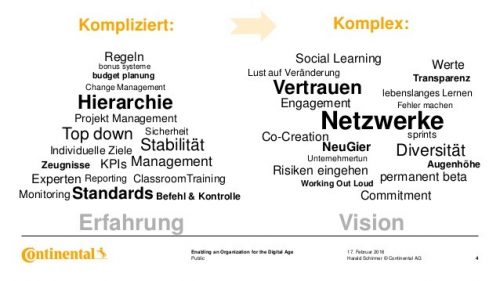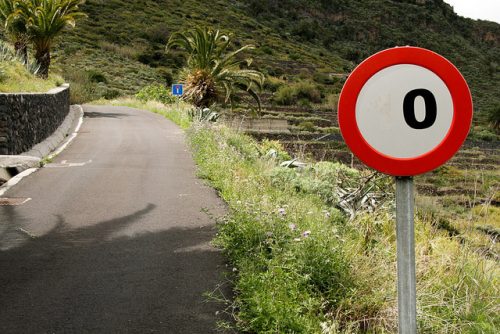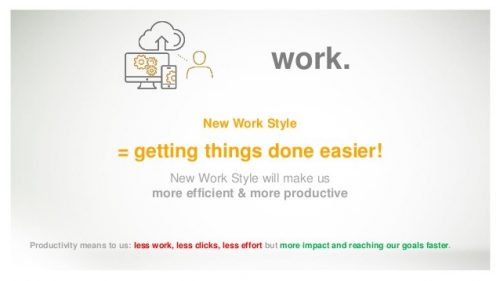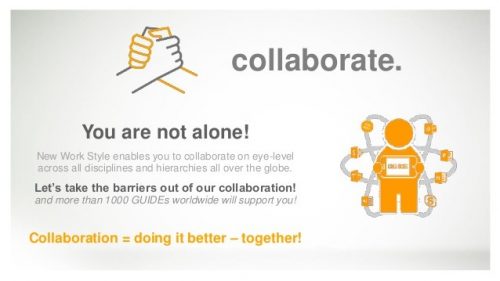This article – originally in German Language on LinkedIn received already more than 9000 views, 400 likes and about 70 valuable comments and more than 1000 re-shares (yes I am a bit proud) Sebastian Kolberg kindly provided the translation here:

- Why is change so difficult?
- How can an organization meet the challenges of the digital age?
- What can I contribute to this?
Not a few ask themselves these questions. Here are some personal thoughts and the hope to encourage you to swim against the current more often!
No, this is not a call to revolution, but a well-intentioned inspiration,
to start with yourself,
no matter if you are a board member, team leader or employee.
Everyone can change the world –at least one’s own… which first creates facts and then has an impact on the environment.
must > want
Where do we come from?
Structured processes, consistently implemented rules and responsibilities as well as detailed guidelines are a success factor for companies and ensure clarity, reliability, consistent quality and good audit results. All this is wonderful in a stable market with predictable customer behavior and complicated but familiar conditions.
This „system“ is designed to create safety, durability and reliability and to avoid disturbances – in some areas even to actively combat them. Creativity, freedom of action, willingness to take risks, fault tolerance or simply being „different“ are out of place here, or are only intended in special „departments“ (e.g. innovation).
Everything is running smoothly
and according to plan.
Then VUCA happened
VUCA = volatility, uncertainty, complexity and ambiguity is commonly used as an abbreviation for the challenges of the digital age.
Real complexity that demands creative, fast solutions, new products, services and markets. All this in addition to global competition with new participants (from other industries or start-ups) and constantly changing conditions (through high networking, dependencies and dramatically increasing number of participants). The political situation, global economic dynamics and country-specific special cases are also having an ever greater influence.
Reinventing yourself… during operation?
…a bit like constructing
an airplane
during the flight
An often observed reaction of companies is the establishment of their own startups, labs or fancy offices in Silicon Valley, Berlin or other innovation hotspots. However, the above-mentioned innovation department is simply outsourced, „taken out of the system„, and thus quickly incompatible with the rest of the company. This (alone) does not solve the dilemma in my opinion to continue to earn money with existing, proven structures and to reinvent oneself at the same time.
Where approvals take days, travel expenses weeks and projects or budget approvals years, you won’t be able to keep up in dynamic markets. How striking the difference is quickly becomes clear when you look at everyday processes: How many people, processes, input masks (or forms) are involved in ordering and setting up a new computer (alternatively mobile phone, business trip), and how long does it take until it is ready set up in front of you?
Or something more digital: Try to „order“ a project logo via a crowdsourcing platform… Oh well, you may not, is not Brand Compliant, if nevertheless, who should the purchase create in the system, if there is no provider and no offer, but you bid on an end result…

Hierarchy and bureaucracy are over 1000 years old, careers and the success of the organization so far are based on the underlying methods and achievements – throwing it all overboard?
The guardians of the system, rules and processes
Of course, it is the task of all the service areas to ensure that the organization has a uniform external effect, that invoices are processed in a comprehensible, cost-effective and standardized manner with the supplier of choice audited, that quality is ensured, that data protection, security and sustainability are checked – this is important.

But while some are still…
shimmy through the hierarchy
through the chain of command
…and hope for budget approval for a prototype, others are already earning money from customers and are on their way to becoming number 1 in the digital market.
Some follow the rules, others just do it.
I consider one to be too bureaucratic and inflexible and the other one often problematic socially (including security, ethics, social) – that’s why I’m working on getting back to something more:
…to inspire for….
- responsible entrepreneurship
- solidarity-based independence
- holistic sustainable action
- blurry, which stimulates self-thinking
- and above all the joy of change

The challenge here is to find a healthy balance that makes the risk manageable but the added value quickly tangible.
Originally, today’s guardians were meant to be supporters of internal processes. Expertise was bundled as the company grew, thus relieving the „business“ of these activities. A Human Resources, IT and quality department, communication and legal department etc. were created. At regular intervals – for understandable, mostly economic reasons – savings were made in precisely these areas: personnel, money and equipment, since these ongoing „fixed costs“ are not offset by any directly calculable value contribution.
Who has to take care of himself,
can hardly take care of others
The long-term consequence: pro-active supporters become silos fighting for status or even survival. How often do colleagues in these areas have to listen to themselves being too expensive, soon to be replaced or outsourced by algorithms. No wonder, then, when risk, effort and service are reduced „on behalf of the system“. If you’re short of cash, you only do what’s necessary:
To forbid something takes seconds,
to find a solution,
possibly days or weeks.

Enough whining – what can I do?
My own way to bring about change is to implement ideas directly and personally (transparently and gladly in a team or network), to question limiting rules, structures, processes and also responsibilities and to open doors through successful experiments.
A first step is to ask new questions! We are surrounded by answers that have usually arisen from past experiences. Now the framework conditions have changed, so a first step would be to ask yourself „new“ questions or to „ask old questions differently – again“!

Usually I don’t ask permission for ideas
…since it is the task of those responsible to demand compliance with specifications – which then ends in a „ban“. In recent years I have met so many people – from the most diverse industries – who were so demotivated when asking for permission that they no longer suggested ideas: „won’t be implemented anyway“, „nobody here will listen“, „not taken seriously“, „not my job“, „you may not“, „has never worked here“, „don’t be so naive“…
Experiments need
a certain freedom
that you have to work out for yourself.

Where to get the time?
If you don’t want to do disruption exclusively in your free time, I recommend you to start with the change in yourself. View and improve your own processes to become more efficient and productive. Ideally, by using the digital possibilities – to achieve more scalable solutions and thus more impact. As long as an organization (the boss) is satisfied with the results, you can allow yourself much more. This principle of
Increasing self-efficacy
… is an important pillar of the GUIDE role I have been trying to establish in global networks since 2011.

WHO can/should take the risk of disruption?
I think the risk is as great for employees as it is for managers at every level or on the Executive Board:
Your own future is at stake.
However, if you look at it from the perspective of the organization as a whole, you can dramatically minimize the risk.
Only the bravest board members or those responsible will have the courage to give general permission or even a specific mandate for disruptive behavior. Top down, the risk for the company’s success is also quickly „total“.

A first approach is certainly to initiate a cultural change that creates healthy humus that encourages personal responsibility, entrepreneurship or experimentation.
Setting an example,
demanding and appreciating
the desired behavior.
In middle management, time and personnel shortages are generally the result of constant efficiency improvements, permanent monitoring and reporting as well as the usual savings. More and more often, however, courageous bosses show up here who find ways to open up freedom for themselves and/or their employees and prioritize joint learning and open exchange.
Some also take the initiative themselves and try new methods, support employee ideas or give security as a „sponsor“ or keep their backs free.
That leaves the bottom-up approach. What if employees somewhere in the company started disruptively breaking new ground, trying out solutions or starting experiments?
For the company,
the bottom-up approach#
means minimal risk,
since the effect at the lower end of the hierarchy is usually very manageable. So if employees take the calls for participation, thinking along with others, experimenting seriously, this can be a great lever for change, if successful things are then taken up and reinforced „from above“.
How can this risk-minimized form of change be promoted or the risk for employees minimized?

- clearly formulate vision, mission and goals (not what should be done, but where we want to go)
- Develop common values that promote this willingness to change (freedom) and slow down wild excesses (connectedness) and, of course, set an example for oneself.
- Making successful initiatives visible
- Become clear about the language and terms used (often martial, destructive or „ridiculous“ expressions are used quite naturally) and change consciously (towards appreciation)
- Do not punish failed initiatives, but use them for learning (protect against consequences)
- Choose event formats that leave room for experimentation, and are not fully planned
- Courage leave a gap: Only when something can be experienced that is missing, and nobody manages, someone will start
- Temporarily „suspend“ processes or rules to test their actual impact (and save resources)
- Appreciation for leaders who become visible as role models for cultural change
- To build a network or coalition of the „willing“ or „curious“ who support each other.
Do not forget the health aspect!
Disruption or rebel behavior
is exhausting!
One perspective that should not be forgotten is the enormous energy that it demands of each individual to work against existing structures.

Who intrinsically motivated leaves the given path, immediately takes responsibility for his actions, and is in the permanent justification or at least explanation mode.
Often a lot of private commitment (financial, time, relationships, competencies) is necessary in order to pursue one’s own ideas parallel to daily business. In addition, all tasks such as planning, possibly searching for sponsors or allies, building prototypes, testing the market, marketing, etc. are also performed.
All of this runs either underground or under the critical eyes of managers or system representatives.
Recommendations for energy sources:
The „being different“ is much longer if you know „I am not alone“ – both as far as the crazy ideas and the experienced resistance are concerned.

- Search for like-minded people (self-aid group;-)
- Talk to colleagues – often there are unspoken topics that need „only one trigger
- Setting up networks (internal and external)
- Build reputation by sharing personal experience (consider privacy, compliance, intellectual property)
- External events on the selected topic
- Benchlearning, MOOCs, podcasts, YouTube…
Conclusion:
People who actually want to make a difference have always taken risks. Change takes time, but when the time for change has come, you can shape a lot.
I am convinced that in our „lifetime“ there was hardly a time when change was as „possible“ as it was now. The great uncertainty in many areas calls for new orders to be found.
Do it yourself!
So often in my environment I hear
„We’re not ready yet.“
… I would like to invite you here to turn this question into a mission: What can we do NOW to be ready as soon as possible?

We should not be too quick to demonize everything that has been built, including respecting the positions of the representatives of the existing. People deal with change in very different ways – what is a longing wish for some means existential danger for others. Respect and empathy are appropriate here.
At the same time I would like to support those (with this article or my other promotions),
to transform the energy
of one’s dissatisfaction
into the courage to act
I myself have been „feeling“ walking against walls for over 25 years… only slowly they crumble. When the time is ripe for change, we should have experience from experiments, have thought out and tried out solutions in order to be able to convince with valuable concepts.
Today, the digital possibilities allow us to quickly address like-minded people or professionals directly, no matter where in the world they are. There are countless motivational possibilities (from TED talks to books, podcasts to the many encouraging videos) now it needs people who dare!
#Doing is like wanting
but more wicked (impactful)
Good luck!
Big thank you again to Sebastian Kolberg for the great translation of my original article at LinkedIn!
Fotos and Pictures done by myself 😉

Schreibe einen Kommentar